#anne's article
Text

Waste not, want not
By HRH The Princess Royal | Published 29 July 2020
EVERY year, month and day, I realise how fortunate and privileged I am to have grown up and spent most of my life in the countryside. It’s not only the space, appreciating the seasons, the wildlife, the plant life, the arable crops and the livestock, but, most importantly, it’s the people who live and work there and understand the complexity of their environment. I was equally fortunate that both my parents had a love and understanding of the natural world through their own experiences. Perhaps even more so for my father when, during his rather disjointed young life, he ended up at school at Gordonstoun and was introduced to the wilds of Scotland, both land and sea. Scotland had its influence on my mother, too, as did the big skies of Norfolk, and the huge fields and marshes of the Sandringham Estate. Windsor’s Home Park and Great Park were a constant presence for her, as they were for all of us. They had horses, dairies, hens, pigs—you could never be bored as a child. Windsor was and is a haven of peace, although not so quiet since the growth of air travel—until the lockdown.
Superficially, not much has changed since I was young; the Jersey herd is still there, although the cows now enjoy a robotic parlour. There are Sussex cattle in the Great Park and the crops are a different mix, but the forest is still there, as are ponds and wet areas, the Savill Gardens and Frogmore House Gardens. Buildings and skills that the Prince Consort would have recognised.
Prince Albert’s influence is seen so often at the forefront of research and practical application, not least in agriculture and building design. His model farm at Windsor, for instance, and nearly all the buildings at Balmoral improved the use of space and integrated more efficient use and better distribution of water. My father was impressed by Prince Albert’s approach to forward-thinking and sustainable developments and has added his own understanding to encourage others to build on the knowledge of their predecessors. The Royal Commission of 1851 was set up by the Prince Consort after the Great Exhibition to build on its success of creativity, innovation and trade. When my father was its president, he oversaw an extraordinary investment in talent across the whole spectrum of research, including the science and practice of agriculture and sustainable land use. I now have the privilege of being its president, which also reminds me of the wealth of knowledge that I have been exposed to throughout my life and the part my family has played in growing that knowledge.
Prince Philip has added his own unique talents by being very well briefed, then engaging and bringing together all interests that are part of the countryside. He is a very hard act to follow, but I’m grateful for the time he gave us and the example he set us.
It is only later in life that you realise how much you have been exposed to and how much you have absorbed from your early years. We were taught to observe and question, to be open minded, to understand differences, to treat every person as an individual with their own skills and to remember there is very little that is completely new under the sun. We are where we are because our ancestors not only survived by living off the land, water and air, but also innovated ways of doing so more easily and successfully; so successfully that a shortage of food seems a distant threat for much of the western world. However, although we may be growing more, the access to and distribution of good-quality foods is still a challenge.
We are living through a real global pandemic that is affecting literally every person’s life in some way, even if they and their countries have barely suffered directly from Covid-19. The effect on global food supplies through the restrictions on transport and logistics (see page 124) should raise our awareness of the vulnerability of the modern—just in time—demand-and-supply approach and highlight the strengths of local production and markets. Change will require all land users to work even more closely together to understand the most appropriate and least damaging way to increase production of crops and livestock that best suit our ground conditions and weather. It also means finding the right space and access for those who wish to enjoy the non-producing areas.
The restrictions that Covid-19 has placed on the entire population have accentuated the pressure between town and country. However, it has also shown that, thanks to historic houses, caravan parks, national parks, forestry enterprises, riding and cycling trails, rambling routes and assorted types of accommodation, access was quite well catered for already as an important contributor to the rural economy. The pandemic has highlighted the number of people and jobs that are crucial to that economy, too, be it the hospitality sector, conservation projects or the farming sector, such as the harvesting of many crops, fruit and vegetables and the care of livestock, especially sheep-shearing. Those jobs are still hard physical work that also need skills to achieve the standards that the buying public expect.
Technology is already making an impact in these areas and will make a bigger impact as the innovators and practitioners work out what is adding value and efficiency, without doing any more damage to the environment. Education and training play a big part in the shared understanding, success and enjoyment of the countryside. Our knowledge is derived from experience, evaluation and development and we need that information to be readily available. The royal agricultural societies, the county agricultural shows and societies (see page 120) —which are often the gatekeepers to public enquiry and understanding—the further-education colleges and universities that still maintain links with the rural economy (see page 128) and the people who live and work in the countryside are more important than ever, especially as there is no such thing as an unskilled job.
Research has made progress, but single-issue research must never lose sight of the overall subject. I mean that, for instance, one type of crop, with very specific qualities, may not be the best crop for every environment. Nature’s ability to adapt is, on the whole, better than humans or, indeed, computer-model-driven versions. How do we combine the best of both, the single-issue expertise and the need for a holistic view? Hopefully, by recognising that practitioners, residents and consumers can all access accurate information, education and training so that they can contribute to the debate and the research on best practice for the countryside.
How do I define best practice? Understanding how to work better with local conditions and working with Nature, which could be by using very traditional methods. Yet also using technology to support farming and related jobs, as well as extending the employment opportunities to those who would rather stay in the countryside. Not everybody does, which is just as well, as there is already a shortage of affordable houses in most areas (see page 118).
One of my pleas for best practice is quality, appropriate housing of the right type and the right numbers in the right places. Housing for local families that are priced out of the market; for young, single people who would like to stay and work in their home village or area; young families; and retired people who were born in the village and would like to return home. All of them could make the difference to having a viable school, shop or pub in the village. Importantly, these housing developments should be small and remain in the control of the local parish council, either for rent or shared ownership—preferably small because of two other best-practice issues: waste and energy.
Waste—produced by humanity and the way it chooses to live—that is not dealt with appropriately is up there with not understanding the value of small housing developments built to last as a major irritation to me! If you want to help the planet, controlling our waste is something everyone can do and it will make a difference. We will always produce waste, however efficient we become, so we must get better at reducing it at every stage and dealing with it better at the end. That means making things such as clothes, furniture, vehicles and supermarket trolleys that can be recycled safely and economically and not dumped on someone else’s ground. Did I mention that fly-tipping is another major irritation to me?
There are some perfectly good waste and recycling systems out there already, including anaerobic digesters and waste-to-energy plants. I would hope we can be more innovative and local in the way we deal with our rubbish to encourage everybody that it is worth making the effort to put waste in the right places, recycle more and have the confidence that it will make a difference.
Everything about life today seems to be about convenience and waste is seen as inconvenient; we must help make it more convenient to deal with. Raising the profile of the country code might help, especially as the post-coronavirus getaway to the country seems to have resulted in an increase of littering and vandalism.
Reliable energy supplies are critical to everybody and renewable energy created by innovative and local solutions will be a crucial part of the networks. Rural areas could be even more self-sufficient, especially if much of the equipment is to be electric. Replacing fossil-fuel generators has not been easy, but covering the countryside in solar panels and windmills isn’t really the answer, either. Using water better, using waste from crops, using waste from woodlands and the ability to store energy, possibly as hydrogen, can all help, but will require a more flexible grid and, therefore, the technology to make that work. Small nuclear reactors could have their place, but perhaps there is not the space to pursue that now.
In order to make rural life less isolated, even 5G coverage will not solve the problem of transport for farmers, shops, schools, pubs and the people who want to live and work in or from the rural environment. You need logistics to travel, to distribute, to deliver and to collect. Many businesses, good ideas and ambitions have failed because there are too few of any of the above and they are too expensive.
The need for appropriate vehicles and qualified drivers has not made it any easier to service the rural areas. I gained my HGV licence in 1974 after, I think, a two-hour test, all driving, starting with the handling test, which meant that, if you touched a cone, you were unlikely to pass. Then you spent the rest of the time driving—in my case, mostly in Reading. There was no theory test and, in relative terms, it didn’t cost very much. Now, it is a serious commitment in terms of time and money, which has resulted in a real shortage of HGV drivers. This, and the requirement for qualifications for nearly every other sort of vehicle, has made it even more difficult to maintain services. The needs of the rural communities during the coronavirus lockdown has underlined the importance of those people and their roles. We would do well to build on that experience.
I have lived at Gatcombe for more than 42 years (see page 80). We were not looking for a farm, but it has been a real privilege to try to work with what we have. Ours is an organic, extensive grass enterprise, usually complicated by running the horse-trial championships in early August. The woodland is a real mix of trees—mostly beeches, but huge numbers of ash of all ages. Who knows how many will survive, but I feel the naturally selected mix could be an important part of the answer.
Perhaps mix is the key. I write as a classic ‘Jack of all trades’, who has the opportunity to listen and engage with the masters of their subjects. Does the little knowledge I pick up make me dangerous or well informed?
Well, some of my information comes from COUNTRY LIFE , a publication that continues to reflect and promote all aspects of rural existence. This week’s edition has generously reflected some of my interests and those of people I believe are making a real difference. I hope the edition will leave you positively optimistic about our country’s country life.

44 notes
·
View notes
Photo



Quinta Brunson Drops an F-Bomb Praising Her Costars During 'Abbott Elementary' Cast's SAG Awards Win
#i stole the caption from an article#its too good not to#look at them winning all the awards#the cast deserves the world#abbott elementary#abbottedit#abbottedits#sag awards#gifs#gifset#gif#quinta brunson#tyler james williams#janelle james#lisa ann walter#sheryl lee ralph#chris perfetti
3K notes
·
View notes
Text
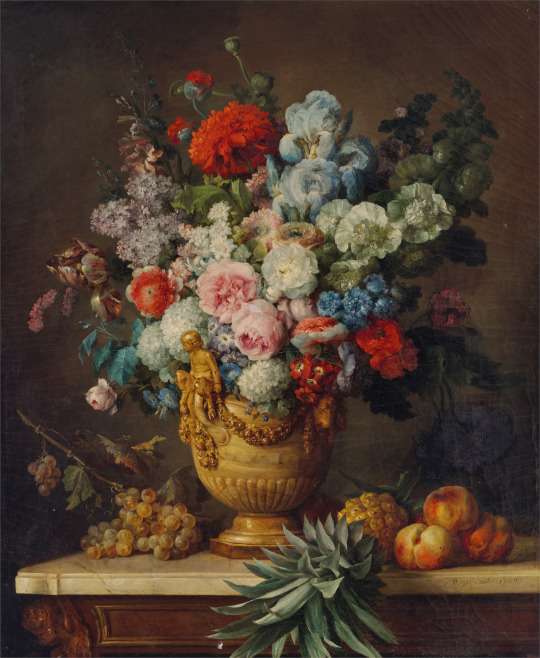
Still Life with Flowers in an Alabaster Vase and Fruit by Anne Vallayer-Coster
French, 1783 (exhibited at the Salon of 1783)
oil on canvas
National Gallery of Art, Washington, D.C.
#recently acquired by the NGA#Click the title of the painting for an article from the NGA about it#still life#painting#art#French#baroque#rococo#female artist#woman artist#Anne Vallayer-Coster#Anne Vallayer Coster#National Gallery of Art#NGA DC
340 notes
·
View notes
Text

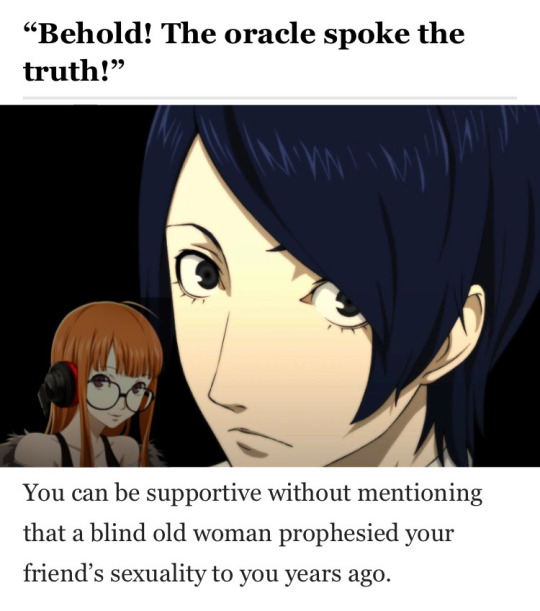

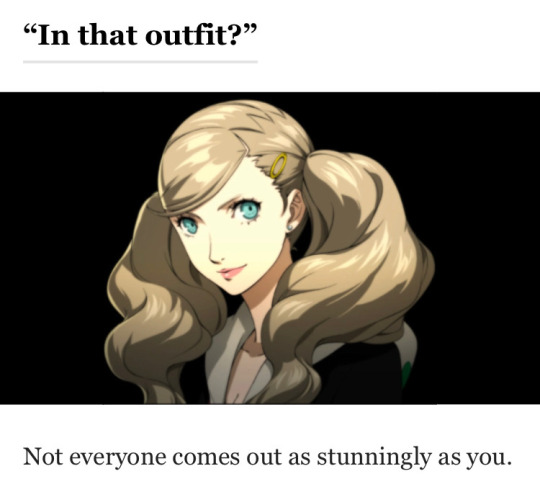




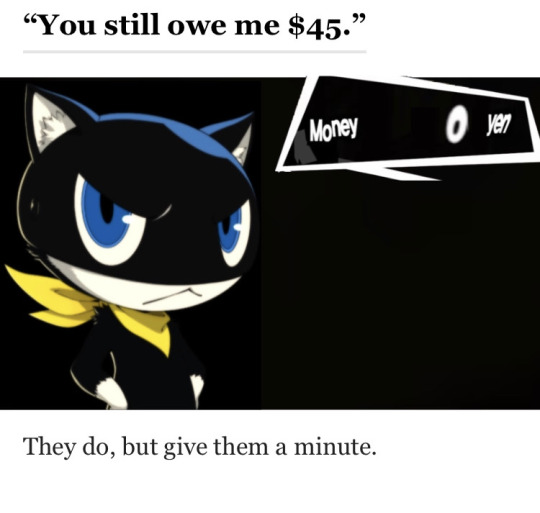
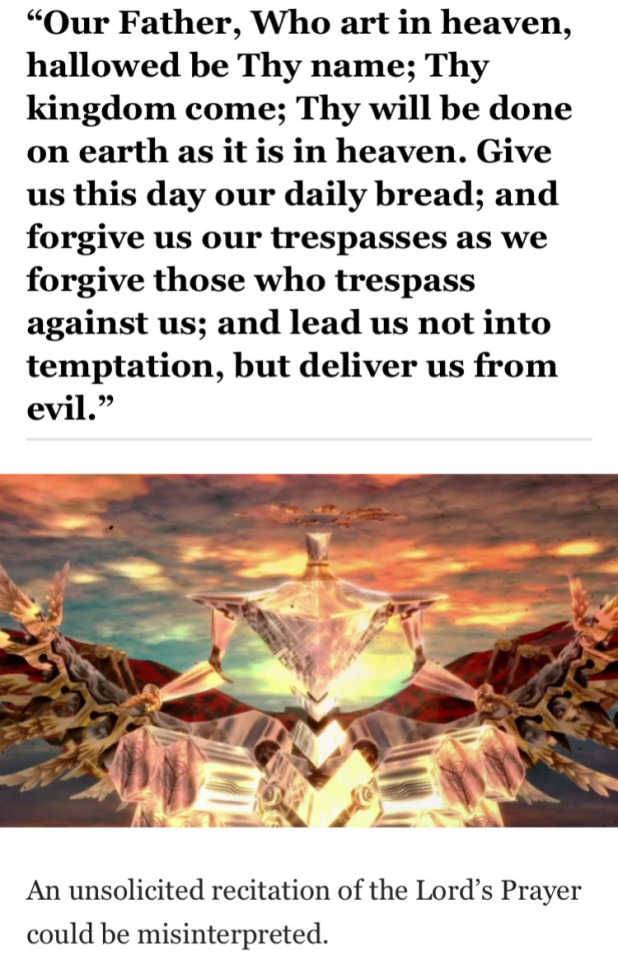
#persona#persona 5#p5#Akira Kurusu#Ren Amamiya#haru okumura#Akechi goro#Ann takamaki#futaba sakura#tae takemi#maruki takuto#zenkichi hasegawa#morgana#yaldabaoth#persona 5 royal#p5r#phantom thieves#incorrect quotes#original article is from The Onion!!#I’m mostly making this for my own amusement lol#mine#persona 5 spoilers
1K notes
·
View notes
Text
On the road with the inexhaustible Princess Anne
8am 800 miles travelled, 12pm 650 hands shaken, 9pm 0 cups of tea drunk
By Hannah Furness, 9 May 2024
The Princess Royal is standing up a 42ft tower, looking out to sea in a north-westerly force six wind. Her hair, that neat up-do that has barely changed in 40 years, does not move, even as a sudden gust blows a seagull past her eyeline.
‘It’s quite exposed,’ she says, with understatement, then gets on with peppering her hosts with questions about tides, volunteer timetables and what precisely the diggers on the beach below are doing.
Outside the watchtower, her arrival in the Lancashire seaside town of Fleetwood has caused the smallest of stirs. A handful of curious dog-walkers gaze at her, camera-phones aloft, and she offers them a brief wave.
Inside, the volunteers of the National Coastwatch Institution (NCI) could not be more excited for a visit from their royal patron. The chairman, Stephen Hand, launches into a stream of compliments about the Princess’s work. ‘If I haven’t made the point clearly enough,’ he finishes, ‘we love her.’
This is her first engagement in a day that will see her travel 421 miles from Gloucestershire to Lancashire, then Merseyside, and back again via helicopter and Range Rover. It is one of 10 engagements in this typical week; she will complete about 450 this year.
‘She’s a dynamo,’ says the CEO of The Pony Club. ‘The best president imaginable,’ agrees the chairman of Carers Trust. ‘She should be queen,’ offers a member of the public. This is said at least once a day.
Not for nothing does she have the reputation as Britain’s hardest-working royal. In numbers of engagements, she and the King vie for the top spot each year. While he and the Princess of Wales have taken time off from public engagements to undergo cancer treatment, the 73-year-old Princess Royal has ploughed on with her head down, her work the definition of ‘unsung’.
Most of the time, that is how she likes it. She has eschewed the ‘rota’ system of journalists, photographers and broadcasters who cover her family’s outings. ‘I don’t go for their benefit,’ she once said of the press. ‘I go for the people who ask me.’
This week, in the middle of April, she has made an exception to grant vanishingly rare permission for The Telegraph to follow her on the road, for a snapshot of her work.
At no small effort from her close-knit team, which has accommodated me in its nomadic office, I have been allowed to document her encounters with the approximately 650 people she has met, the many charities and organisations she has put in the spotlight – and report from inside a Windsor Castle investiture for the first time.
I’ve spent seven years writing about the Royal family, travelling across the UK and the world to watch them at work, but Princess Anne’s no-fuss, no-frills team is unlike anything I’ve seen up close before. Professional and precise, she barely stops – every hand is shaken and every minute counts.
The Plan
The Princess’s diary is set months in advance. Twice a year, her office sends an invitation to 300-plus organisations she is affiliated with, asking for their requests for her time. Typically she’ll receive 1,000 to 1,200 requests a year – some suggest a visit, others ask her to write forewords to books, or ask for meetings. All are compiled into a database, arranged by date and region, and printed neatly in a book for the Princess to study. ‘[She] goes through everything required and decides what she’s going to do and when,’ says a member of the team. A planning meetings follows – and ‘once [the programme is] set, she sticks to it’.
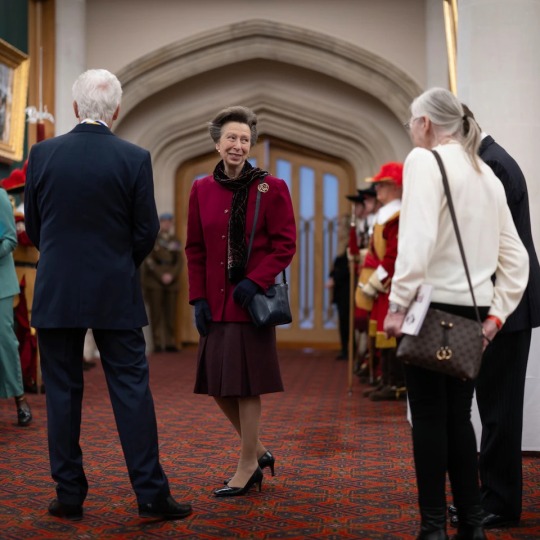
Across the year, the Princess Royal travels the width and breadth of the United Kingdom
Her staff then go through it again to add last-minute audiences into the gaps. ‘The week is there to be filled,’ one long-serving team member tells me. ‘If she’s got a free hour and a half in London, we’ll look again to see what else to add.’
The Princess’s team is small but mighty. There’s her private secretary, Colonel John Boyd, who is fresh from 32 years in the British Army; her deputy private secretary, Commander Anne Sullivan (the double Annes occasionally cause confusion for outsiders); as well as five programme managers tasked with ironing out the exact schedule, right down to how long the Princess can spend talking to each person.
They are aided by 13 ladies-in-waiting, spread geographically, who accompany her out and about. Some of her first, who began working with her in the early 1970s, have only just retired.
‘You never quite know what she’s going to say yes to, but it’s never an outright no,’ says the long-serving team member of her schedule. ‘She’s probably been to more industrial estates than any other royal.
Monday - Estimated miles travelled - 0 (worked from home)
Hands shaken - 8
‘It’s a balance of what do the organisations want, what could she hear or learn or teach here? Every day is a school day where the Princess is concerned.’
At Gatcombe Park, her Gloucestershire home, the Princess’s assistant, Donna, welcomes a small group of eight smartly dressed representatives from the Royal Dairy Innovation Award with a cup of tea and a biscuit.
The Princess joins them once they are settled, in a homely barn conversion with framed seascapes on the walls. She reassures them that it’s ‘not going to be one of those formal events’, then starts grilling them about the Nova Scotian dairy industry and on-shore salmon farming.
Ash Amirahmadi OBE, winner of the prestigious Princess Royal Award, is there to officially collect the certificate honouring his leadership in the dairy industry. Afterwards, when the private engagement has sunk in, he tells me: ‘We had practised our formalities but she immediately put us at ease.
‘I was thinking, “How does she know this stuff, and how does she remember?” I come across eminent scientists and business leaders and not many have a better understanding of the food system than the Princess Royal.’
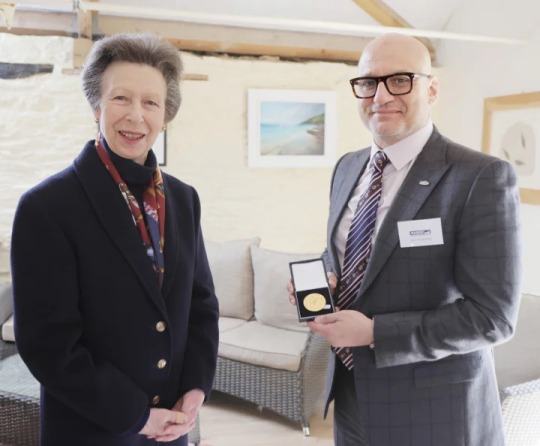
Ash Amirahmadi, the winner of this year’s Princess Royal Award, pictured with the Princess Royal
Before he leaves, the Princess tells him that she’ll be in touch to sign him up to deliver a speech at a conference next year.
She fits in a horse ride, dodging the worst of the day’s rain and hail she feared could be ‘painful’.
‘There’s no such thing as bad weather,’ she says later, with satisfaction. ‘Only inappropriate clothing.’
Tuesday - Estimated miles travelled - 421
Hands shaken - 200+
In Fleetwood, the wind whips across the sandy beach and the Princess Royal doesn’t flinch. She is there with a handful of volunteers from the NCI, celebrating its 30th anniversary. With an average age of 69, these are the local ‘eyes and ears’ that saved 22 people from trouble in the water last year by raising the alarm.
After a turn with the telescope, the Princess – wearing a navy-blue coat, colourful silk scarf and (the now famous) wraparound sunglasses – reaches the top of the Rossall Point Observation Tower, which looks out over Morecambe Bay, where conditions can be treacherous.
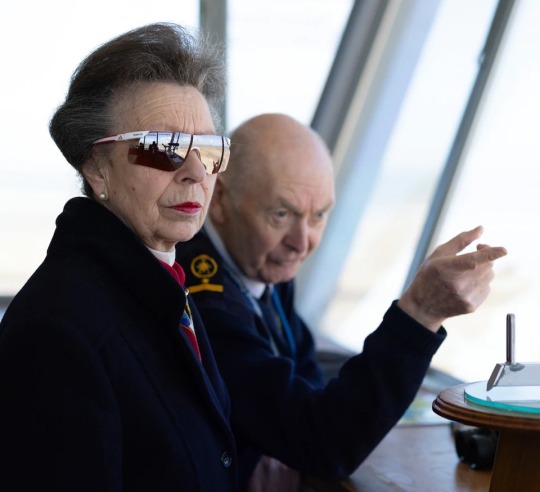
The Princess Royal inspects the Rossall Point Observation Tower
‘It really is extraordinary,’ she says. ‘Classically people say the sea is never the same, but in a place like this it really never is the same. The seasons, the bird life, the activity…’ Everyone nods.
This visit, it emerges, has little in common with most royal engagements, where guests of honour hear how things work. This has more of an air of a diligent business manager checking in on a regional branch. Nothing needs explaining to the Princess, a keen sailor and lighthouse aficionado, and she wins the approval of what could be a tough crowd with on-the-money observations about tide timings.
She speaks sparingly. Questions and remarks are formed from one or two words: ‘Since?’ ‘Previous experience?’ ‘Quite handy.’ She has a reply to everything, having travelled every inch of Britain in the line of duty.
John Bradford, who at 77 is the longest-serving volunteer, waits on the tower to shake her hand, but he is accidentally missed. The Princess is swept on to the next part of the engagement, presenting long-service awards and meeting 25 more volunteers in the nearby Marine Hall, accompanied by her new lady-in-waiting Dolly Maude, a midwife and friend of Zara Tindall who wastes no time in charming the room.
When her team discover someone has been missed out, they tell the Princess directly and Mr Bradford is whisked into the very last line-up.
‘I’m very glad you made it in,’ the Princess tells him, spending an extra few moments in conversation.
Then, plaque and certificate duties completed, she disappears to a back room where sandwiches are on offer. Ten minutes later, she’s back on the road.
It is a cliché that the Royal family thinks the world smells of fresh paint. The ground floor of the watchtower was drained of flood water shortly before the Princess’s arrival and the corridors at her next engagement in Merseyside have the distinct smell of bleach – but at the Wrea Green Equitation Centre in Preston, it is quite the opposite: a muck heap has been left intact. The hosts deem futile any attempts to fool the Princess into thinking it didn’t exist. She is, after all, a life-long equestrian.
She arrives on time; I do not. Without a helicopter, it’s impossible to keep up with her formidable itinerary.
Skipping the champagne reception and tea party, put on to celebrate 25 years of the Pony Club Centre Membership Scheme, the Princess instead strides around the yard watching the young riders and their parade of ponies.
She tours the stables and classrooms, chatting to children about horse massage and how side-saddle is still relevant for people with prosthetic legs, then she holds a presentation of commemorative plaques to 20 proprietors, each of whom has a different chat with her.
When a ‘naughty pony’ in a stable behind her unties itself to join the royal party, she is entirely unfazed.
‘She didn’t mind a bit,’ says Marcus Capel, CEO of The Pony Club – she simply carries on talking while stroking the pony’s ears.
The third engagement of the day: Sefton Carers Centre at Waterloo in Merseyside, which supports unpaid carers. Some of those assembled remember the Princess from 30 years ago, when she opened the centre. She is back to celebrate the anniversary.
Wearing a red jacket that looks strikingly similar to the one she was wearing back then (only the length and buttons are different), she hails a stream of people with a cheerful, ‘I haven’t seen you for a while,’ and, ‘This has changed a bit.’

The Princess Royal visits the Sefton Carers Centre to celebrate its 30th anniversary
Everyone is assembled in horseshoe shapes – her preferred arrangement for talking – and she ploughs on with gloved handshakes, getting through five large rooms of people. Among them are two men in their 90s who care for their wives with dementia, an eight-year-old girl in a wheelchair dressed as a princess, and teenagers who look after siblings and parents before and after school.
Some are nervous; a few curtseys are a little shaky. The Princess has a neat trick: her questions get more specific – no opinions are required, just short, easy-to-recall facts, to help ease them in. ‘Where do you live?’ ‘How long have you been coming here?’
Her own opinions are brief, delivered as common sense. On hearing that GPs don’t see the same families from cradle to grave any more, so find it difficult to support carers, the Princess says: ‘That’s part of the way people live their lives.’
She spends a few extra moments talking to the building’s cleaner, loudly declaring her ‘very important’. When one woman jokes about her long service, adding, ‘I think my face shows it,’ the Princess does an exaggerated double-take and says, ‘I’m sure that’s not true.’
She has another habit, shared with King Charles, of ending engagements by turning back for one last comment, leaving the impression she wishes she could stay.

The Princess Royal cuts the cake, on the promise it will be eaten
Downstairs, she unveils her third plaque of the day. There is a celebratory cake on the table in front of her and an expectant crowd waiting. She takes control of the moment. ‘You want the cake cut? On the basis that you’re going to eat it? Otherwise it’s just vandalism.’
Before she leaves, she is presented with a large rose planter. ‘Oh my word, a monster!’ she marvels. ‘What a lovely thing… I hope the helicopter can cope.’
By the end of the day, in small heels and with the briefest of breaks, she has spoken to at least 250 people. If she’s flagging, it doesn’t show.
Wednesday - Minutes of continuous conversation - 180
Hands shaken - 140
At 11 o’clock in Windsor Castle, Yeomen of the Guard stand on duty in the Grand Reception Room, as the Countess of Wessex’s String Orchestra plays quietly. The Princess Royal moves into position, wearing naval uniform, and the orchestra strikes up with God Save the King. Standing on a dais, a red velvet stool placed in front of her, she is ready for a full day of investitures.
The Princess is one of only three members of the family who perform them and while the King and the Prince of Wales have been needed at home, she has been carrying the load.
Some 140 people will receive an honour today, among them Paul Hollywood, who is being made an MBE. The pair discussed the smells of baking, he says later. ‘She loves Chelsea buns. I did promise her some so I’m not quite sure how I’m going to sort it out.’

The Great British Bake Off judge Paul Hollywood was among those honoured by the Princess Royal
Diana Parkes, a domestic violence campaigner who has worked with Queen Camilla in memory of her daughter, is made a CBE. She finds immediate common ground with the Princess via a family member who sold her horses.
One of the large team that makes the investitures happen tells me quietly that ‘you can always tell when it’s HRH’ on duty, because the day takes longer.
In theory, the Princess has her deputy private secretary on hand to jog her memory with details about people as the Lord Chamberlain announces each name. In practice, says a long-serving aide, she sends investiture notes back with her own comments about where she has met people before and which of her patronages they have links to. This is the case ‘95 per cent of the time’.
‘She’s got such a great brain. We often hear, “You must have briefed her really well,” but no, it’s all her. She makes it very easy in that respect.’ As each encounter winds up with a brisk handshake, recipients walk backwards to bow – desperate to get it right before rejoining their watching families. The Princess smiles at each one like they could not have performed it better.
After the 90-minute session has overrun slightly, she takes lunch in the private apartments before repeating it all in the afternoon.
Thursday - Core working hours - 9
Hands shaken - 250+
London’s Guildhall. The Princess Royal arrives via train for The Lord Mayor’s Big Curry Lunch, a City fundraiser for military veterans which has raised more than £3.3 million since it began in 2008.
To walk in as an outsider is to enter a new world where London’s livery companies (guilds dating back to medieval times) line the corridors with stalls – the Worshipful Companies of Bakers, Fruiterers, Gardeners, Pewterers and Framework Knitters are all there.
The Princess has no entourage, only her protection officers and one lady-in-waiting. She does not bat an eyelid at being escorted in by members of The Company of Pikemen & Musketeers, who wield weapons from the Charles I era and take their roles seriously.
Guests are an eclectic mix – a pearly queen mingles with barristers and bankers, alongside the military. An injured veteran in his mid-30s tells me: ‘In the Army, I’ve often been in front of high-ranking people who don’t care what you have to say at all… She’s different.’
Michael Hockney, co-chairman of the event, says the Princess is ‘very well-known and popular in the City because she’s involved in the livery movements’.
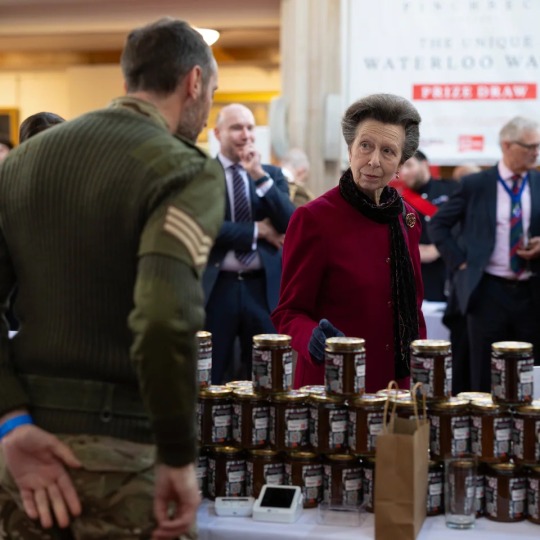
The Princess Royal greets the traders at London's Guildhall
Lunch is served on long tables. The Princess sits with servicemen and women, eating from an identical plate piled with chicken tikka masala, prawn malai, dal, rice and mango chutney.
Ballanupalli Sainath Rao, executive chef, asks if she remembers her last visit, in 2015, when she said she knew the factory of the company supplying the food and thought they could offer more variety than chicken every year. ‘Two meats and three vegetables,’ she suggested. Chef Rao added the prawn dish on that advice. ‘We had a lot of compliments.’
The Princess is plied with goodie bags, including matching socks for her and Vice Admiral Sir Tim Laurence, her husband. On her way out, she views a small garden with artwork by children from forces families and inspects a stall from the Worshipful Company of Fishmongers (est 1272); the stallholders have been hastily restocking ice and swatting away flies as they wait in the sunshine.
‘She was saying it’s great to see the array of fish,’ fishmonger Andrew Kenny explains afterwards. ‘She asks really precise questions… It’s very disarming.’
Climbing into a waiting car, the Princess tells the organisers: ‘[I’m] not causing too much chaos, I hope.’ And then she’s off – next stop Buckingham Palace.
At 7pm, the Princess Royal walks through the ‘secret door’, disguised as a mirror and cabinet, which links the Palace’s private rooms to the White Drawing Room, a State Room with a gold piano, familiar from some of the late Queen Elizabeth II’s Christmas broadcasts. Tonight, she is hosting a black-tie dinner to celebrate The Duke of Edinburgh’s Commonwealth Study Conferences, which bring together future leaders to address pressing problems facing the world. In particular, she is saluting the Canadian team, which has led the way in hosting the conferences and keeping her father’s vision alive.
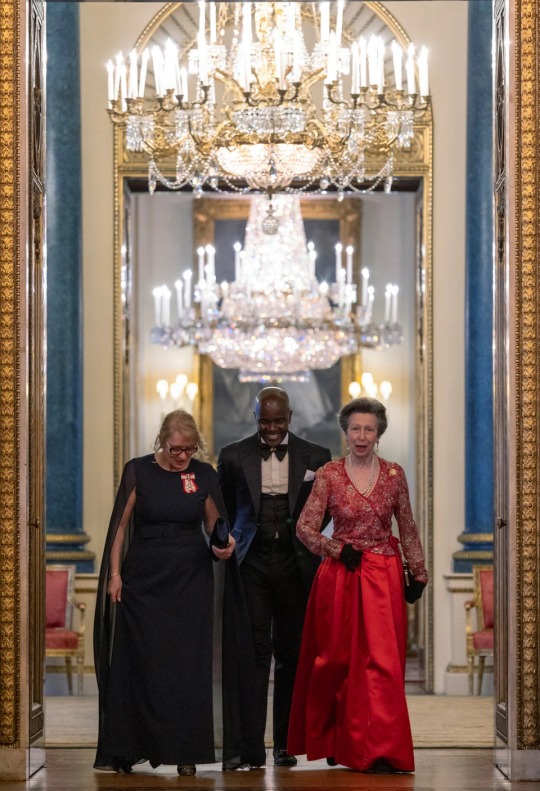
The Princess Royal enters Buckingham Palace's White Drawing Room via the secret door.
Wearing a long skirt and sequinned jacket in red to match the Canadian flag, she carries a handbag under her arm and wears her late mother’s three-strand pearls. Unlike other royals, the Princess’s team won’t confirm to the press what exactly she is wearing. One suspects anyone who asked would get short shrift.
She spends roughly an hour in the Picture Gallery, working her way through a crowd. One guest tells her of her memories of a drinks reception with the late Queen and Prince Philip on Britannia, during their visit to Ontario in 1984. Asking another about their trip to London, she agrees that walking is the best way to get around, although ‘not at this time of night and dressed like this’.
Ahead of a dinner of poached citrus salmon salad, roasted lamb, and crème brûlée with poached rhubarb, the Princess delivers an eight-minute speech. At one time, she is said to have written every speech herself. Nowadays, she often works from prepared notes, which she edits ruthlessly with liberal red pen strokes and capital letters.
The conferences, she says, were ‘envisioned by my late father, but I suspect he never thought it would last this long.
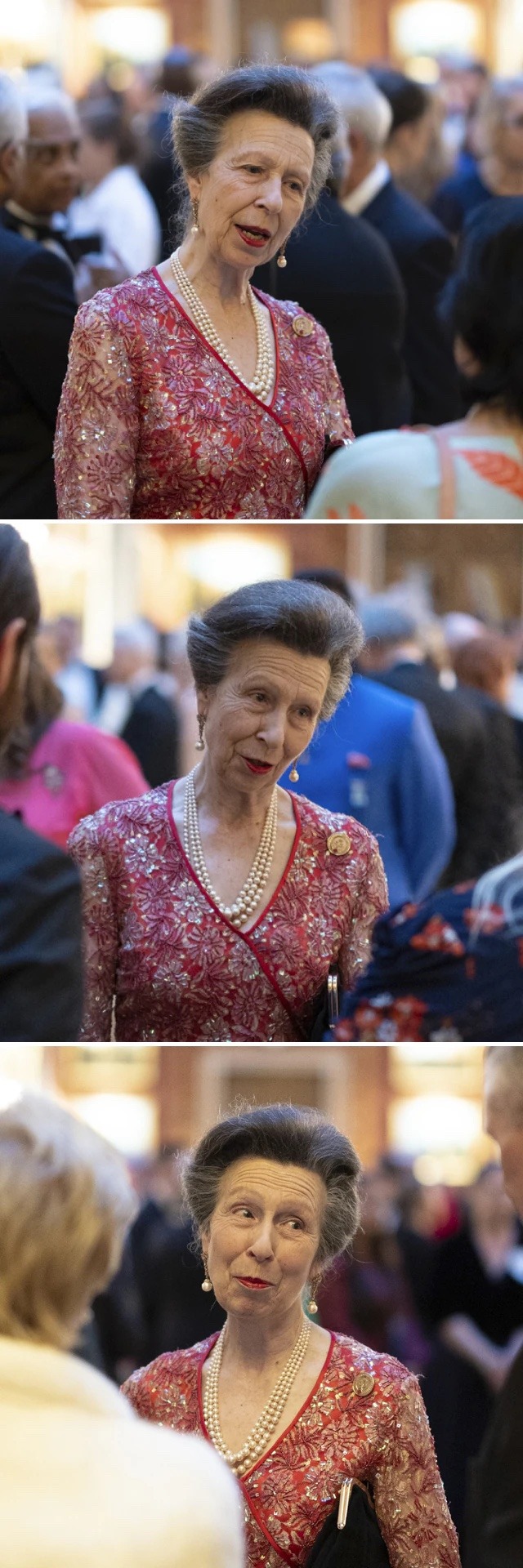
The Princess Royal greets guests at the Duke of Edinburgh's Commonwealth Study Conferences dinner.
‘At the moment, in these rather difficult times – post-Covid and just generally complicated – it’s just as important to have the ability to bring people together across the widest possible range.’
The Princess will stay on for dinner, sitting at a round table and entertaining guests until long after sundown.
Friday - Minutes on feet presenting honours - 90
Hands shaken - 79
Friday morning and the Princess is back at it with an investiture. There are 79 people this time, with their families, in the Throne Room at Buckingham Palace.
Neil Constable, former CEO of Shakespeare’s Globe, is here to receive his OBE for services to theatre. He says afterwards that the ‘professional’ Princess knew the brief so well that she could make conversation about both his previous job and his next, at The Musicians’ Company. She told him she had just been to the Guildhall that week for the Big Curry Lunch, adding, ‘You’ll have a great time with them.’
‘You leave thinking, wow, actually we had a really good conversation,’ he says. ‘We talked about her late father Prince Philip being a long-standing patron of the Globe and how some of the timber from the Globe came from Windsor Great Park’, donated by Prince Philip.
‘[She] made it a very special day.’
At this point, I close the notebook that clocks in at 84 pages of shorthand. Everyone – kindly, warmly, generously – is saying the same thing, and we have run out of superlatives. The job, too, must get repetitive but you would never know it. In continually asking questions, the Princess has found a way to keep interested even after all these decades.

Princess Anne salutes at the conclusion of a commissioning ceremony aboard HMCS Max Bernays as part of Fleet Week, in North Vancouver, B.C
She treats her work as a ‘nine-to-five job’, one Palace source tells me. ‘Except it doesn’t often finish at five.’ I have barely seen her sit and haven’t seen her accept a single cup of tea while working.
The week after we meet, the Princess will be in Windsor, Shropshire, Cambridgeshire, London and Cornwall. After that, she will go from the Royal Windsor Horse Show to Canada for a three-day trip with Sir Tim.
She will be 75 next year but shows no sign of slowing down. I am half her age – and after barely a week of trying to keep up with her, I’m off for a lie down.
Weekly total
Estimated miles travelled - 818
Hands shaken - 677+
#a fascinating insight in the princesses week#i love articles like this#matching socks for her and her hubby#that curry plate sounds delicious 🤤#hardest working royal 🫡#princess anne#princess royal
129 notes
·
View notes
Text
In defence of Will Ladislaw
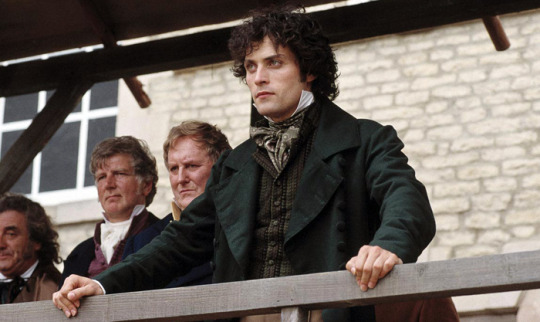
George Eliot's characterisation of Will Ladislaw is one of the few aspects of Middlemarch that is not universally praised, with no less a person than Henry James commenting in 1873 that he lacked “sharpness of outline and depth of color”, making him the novel’s “only eminent failure.” And while Will's character is certainly not as clearly defined as some of the other characters in the novel, I believe that this was absolutely intentional on Eliot's part. Middlemarch is full to the brim of characters who believe they know exactly what they want—not least among them, our two protagonists, Dorothea Brooke and Tertius Lydgate, whose ardent ambitions and inflexible attitudes lead them into catastrophic errors of judgement and unhappy marriages.
By contrast, Will's lack of strongly defined goals and his changeability are almost his defining character traits. He's aimless and pliable, prone to rapid mood swings and drastic career changes, with even his physical features seeming to "chang[e] their form; his jaw looked sometimes large and sometimes small; and the little ripple in his nose was a preparation for metamorphosis. When he turned his head quickly his hair seemed to shake out light."
Will’s inscrutability is closely tied to his ambiguous status within the rigid class structure and xenophobic society of Victorian England, with his Polish ancestry and “rebellious blood on both sides” making him a target for suspicion. He is repeatedly aligned (and aligns himself) with oppressed, marginalised, and outcast populations—Jewish people, artists, and the poor.
He serves as a narrative foil for characters like Lydgate and Edward Casaubon, who prioritise specialist expertise above all and are consequently incapable of broad knowledge synthesis. He critiques Casaubon's life's work as being "thrown away, as so much English scholarship is, for want of knowing what is being done by the rest of the world." By contrast, Will serves as Eliot's defence of the value of a liberal education. One of the first things that we learn about him is that he declines to choose a vocation, and instead seeks to travel widely, experiencing diverse cultures and ways of life. He has broad tastes and interests, trying his hand at poetry and painting before eventually pursuing a career in politics.
He also functions as a narrative foil for Dorothea. Will is initially apathetic to politics, whereas Dorothea initially professes herself to be disinterested in art and beauty. This is perfectly encapsulated in their exchange in Rome, when Dorothea declares, "I should like to make life beautiful—I mean everybody's life. And then all this immense expense of art, that seems somehow to lie outside life and make it no better for the world, pains one", to which Will replies, "You might say the same of landscape, of poetry, of all refinement [...] The best piety is to enjoy—when you can [...] I suspect that you have some false belief in the virtues of misery, and want to make your life a martyrdom.”
By the end of the novel, Dorothea unlearns some of her puritanical suspicion of sensual pleasure, whereas Will becomes more serious, compassionate, and politically engaged, dedicating his life to the accomplishment of humane political reforms. They are both flawed individuals, who ultimately become more well rounded through their relationship with each other. Admittedly, Dorothea's influence on Will is more significant than his on her—and once again, I believe that this was intentional on Eliot's part.
In my opinion, the negative response to Will Ladislaw at the time of Middlemarch's publication (and in the centuries since) was and is profoundly informed by gendered expectations of masculine dominance in romantic relationships. Will's marriage to Dorothea has often been described as disappointing, with many readers and critics viewing the ambitious Lydgate as the embodiment of the ideal husband that Dorothea outlines at the beginning of the novel—a talented man engaged in important work for the betterment of humanity, to whom she can devote herself.
However, one of the central themes of the novel is that people are often mistaken in their beliefs about what they want, and Dorothea's marriage to Edward Casaubon certainly demonstrates that she would not in fact be happy living her life in submission to a man who does not respect her opinions. I firmly believe that Lydgate's misogynistic attitudes and expectations would have made it impossible for him to be happy in a marriage of equals with a woman like Dorothea. He is explicitly drawn to Rosamond Vincy because she has "just the kind of intelligence one would desire in a woman—polished, refined, docile."
By contrast, George Eliot made a deliberate choice to pair Dorothea with a man who is not ashamed to be influenced by her, and indeed looks up to her as his moral superior. Through Dorothea's influence, Will discovers his life's work. In turn, by marrying Will, Dorothea is able to pursue her true passion. As a result of their influence on each other, these come to mean the same thing—reform. Thus, George Eliot grants Dorothea Brooke a subversively feminist, politically progressive, and profoundly cathartic ending: a life of companionate marriage, sensual pleasure, and meaningful work, in which Dorothea can devote herself (within the limited means available to her as a woman in the 19th century) to the achievement of just and compassionate reforms that "make life beautiful" for everybody—herself included.
#PUT SOME RESPECT ON HIS NAAAAAME#hello please enjoy this fucking essay that I wrote#I haven't cited them here bc I'm not insane but I did in fact read several academic articles while writing this post#so if you wanna see my sources/ do some further reading let me know#i love pouring all my fandom energy into content that no-one gives a shit about#(girl who just posted an Alias Grace fic that noone will ever read and is currently working on a Middlemarch fic noone will ever read voice#Middlemarch#George Eliot#Mary Ann Evans#Will Ladislaw#Dorothea Brooke#Edward Casaubon#Tertius Lydgate#classic literature#19th century literature#classic lit#books
107 notes
·
View notes
Text

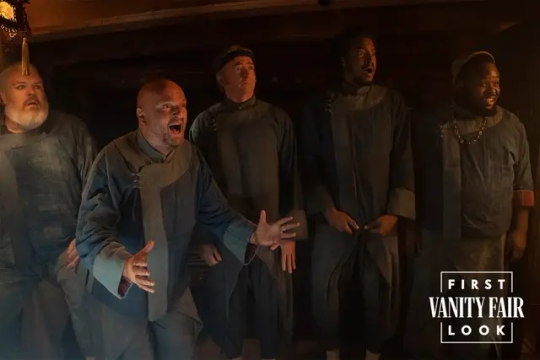


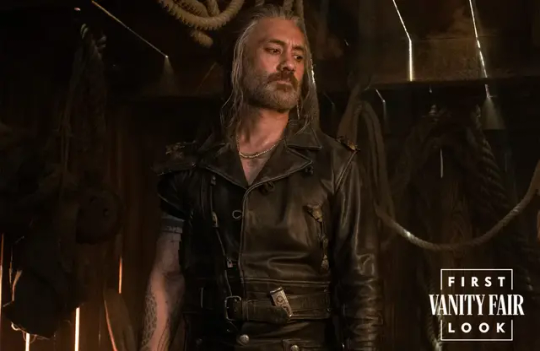

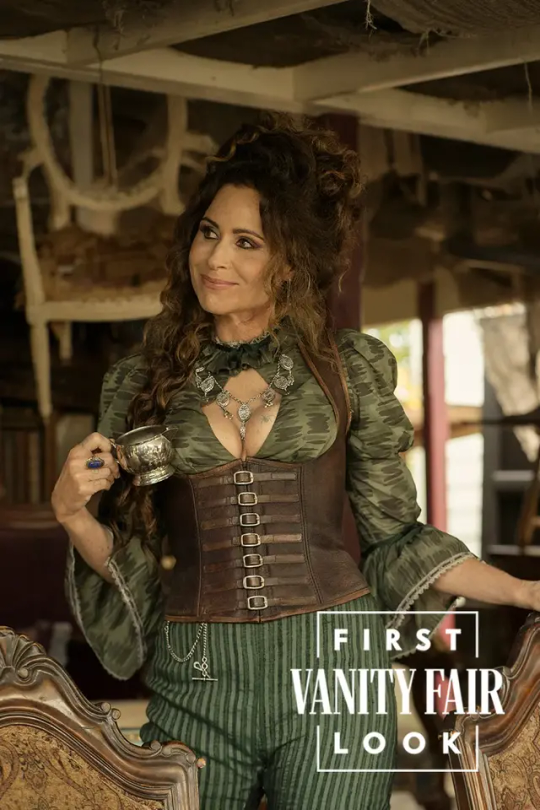

Vanity Fair First Look at Our Flag Means Death Season 2
#our flag means death#ofmd#ofmd s2#ofmd spoilers#edward teach#stede bonnet#black pete#wee john feeney#oluwande boodhari#roach#spanish jackie#i'm going absolutely insane you guys#i dropped my phone and my coworker asked me what was wrong lmao#minnie fucking driver as anne bonny????#ED'S WHOLE THING???#*STEDE'S* WHOLE THING???#WHATEVER THE FUCK IS GOING ON IN THAT SECOND PHOTO OF THE CREW??#and don't get me STARTED ON THE ARTICLE#izzy is a hopeless romantic enraged by unrequited love#actually that's getting its own post
236 notes
·
View notes
Quote
Marie Antoinette went to extremes in the matter of extravagance and self-decoration, and lost her head because of it. But across the years she stands for an example of daintiness and luxury and pretty things. Look back over the pages of history and see how the loveliness of women has always spurred men—and nations—on to great achievement! Try to think of some woman who made a place for herself in world history, who swayed hearts and empires! These women wanted to choose their destinies—to be successful competitors in the great game of life.
Zelda Fitzgerald, “Paint And Powder” (The Smart Set, May 1929)
#gotta love how the message of this article is essentially 'even ugly women can be successful if they put mascara on'#oh zelly#the last sentence has me dying to put this in my anne tag#but alas i have abused my anne tag enough this month#zelda fitzgerald#literature
318 notes
·
View notes
Text
"Royal Family persuaded Queen to end her days at Balmoral"
Princess Royal discloses Elizabeth II feared making life difficult if she died in Scotland
by Hannah Furness, Royal Editor
The late Queen was persuaded to spend her final days at Balmoral as she and the Royal family made preparations for her death, it has emerged.
Queen Elizabeth II had initially feared "it would make things more difficult" if she died at her beloved Scottish home, the Princess Royal has disclosed. Her family eventually convinced her to put her own comfort before her concern for others after a lifetime of duty.
Speaking of her mother's last days in a BBC documentary about the coronation of King Charles III, the Princess described how the family had tried to persuade her that practical issues "shouldn't be part of the decision-making process".
It is the first time the Royal family has spoken of arrangements for the late Queen's death.
Queen Elizabeth II died peacefully at Balmoral in Scotland on Sept 8 last year, aged 96, after reigning 70 years.
She had extended her annual summer stay at the Aberdeenshire estate, where the Prime Minister asked to travel to Scotland to spare her the journey back to Buckingham Palace for what turned out to be her final engagement.
Her children, grandchildren and great-grandchildren had visited Balmoral over the summer, as concern for her health grew. The Duke of Sussex and his family did not make the trip, having fears over their security.
At the time, the palace described the Queen as having "episodic mobility problems", with a series pf cancelled engagements in early 2022 giving way to a peaceful summer without expectation she would appear in public.
In September, she invited Liz Truss, her 15th prime minister, to form a government from Balmoral, breaking with a lifetime of holding the audience in London or Windsor. Then, it was said the Queen had been advised not to travel, with plans for Boris Johnson and Ms Truss to make the 1,000-mile round trip to Scotland instead.
Now, speaking in the documentary, the Princess Royal has paid loving and characteristically practical tribute to her mother.
"We always enjoyed being at Balmoral", she says in a programme to be broadcast on Boxing Day. "We spent a lot of time there in our youth and a lot of it was probably a more independent life than anywhere else. I think there was a moment where she felt it would be more difficult if she died at Balmoral. I think we did try to persuade her that that shouldn't be part of the decision-making process. So I hope she felt that was right in the end, because we did".
The Princess was the only member of the Royal family to be at Balmoral when it became clear the Queen was entering her final hours.
The then Prince of Wales and Duchess of Cornwall made an emergency journey from Dumfries House in Ayrshire, with other senior members of the family arriving after she had died.
Speaking of the moment at St. George's Chapel when the Crown Jeweller removed the crown, orb and scepter from her coffin, the Princess told BBC One programme Charles III: The Coronation Year: "When he takes the crown off the coffin, I rather weirdly felt a sense of relief. Somehow that's it, finished. That responsibility being moved on".
Speaking of her brother, who became King instantly, she added: "To be honest, I'm not sure that anybody can really prepare themselves for that kind of change. At least no easily. And then the change happens and you go OK, I know need to get on with it".
The documentary will share behind-the-scenes footage of the King's preparation for his Coronation in May.
The Princess Royal is the only member of the Royal family to be interviewed on camera. The Prince of Wales and the Duke of Edinburgh appear in footage, with no sign of the Duke of Sussex or Duke of York.
103 notes
·
View notes
Text





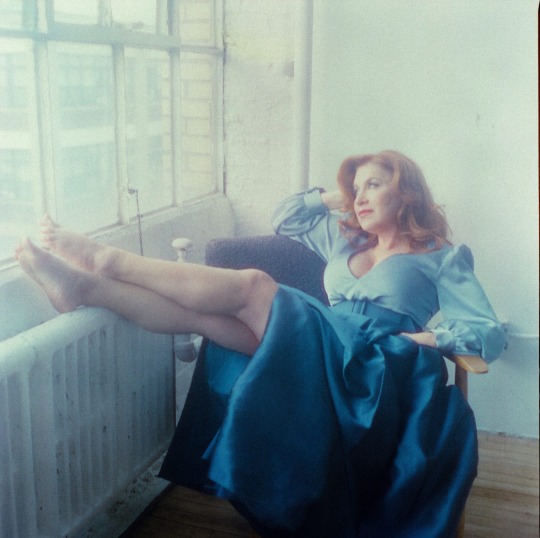

MY JAW IS ON THE FUCKING FLOOR part. 2
Lisa Ann Walter for 1883 Magazine
#lisa ann walter#law#abbot elementary#listen I’ll never be over this article + photo shoot#she looks so beautiful#im on my knees
71 notes
·
View notes
Text
“He's just the same as he has always been,'” she says. “As a very little boy, he was very much like he is now, just a smaller version.”
Like any good mother, though, Anne doesn't favour either of her two children ahead of the other. Harry's older sister Gemma, 32, is a writer and podcaster and herself has more than nine million Instagram followers.
“I'm very proud of both Harry and his older sister Gemma and the adults they've become,” she stresses. “They're both really hard working, they've got good morals and they're kind people.”
“I know it sounds like a dreadful cliche but as long as they're happy, that's the most important thing.”
What's clear today is that behind the enormous star lies a tight-knit family. “Oh yes, we're all close, it's just geography,”says Anne. “We all see each other when we can.”
-Anne talking about Harry. (8 April 2023)
342 notes
·
View notes
Text
"Nick is innately handsome, intelligent, sensitive, funny, sporty and dashing. … And I know he’s got much, much more to show [...] Nick could have chemistry with a lamp. He’s so easy to connect with.”
- Anne Hathaway talking about Nicholas Galitzine (Washington Post - April 2024)
45 notes
·
View notes
Text
Princess Anne has been handed a starring role by the King for his coronation in honour of her years of unwavering loyalty.
The Princess Royal will feature in the procession as the prestigious “Gold-Stick-in-Waiting”, a position historically handed to a person entrusted with the personal safety of the sovereign.
As a “personal aide-de-camp” to His Majesty, Anne will travel on horseback behind the new King and Queen after they are crowned at Westminster Abbey on May 6.
As Charles and Camilla ride in the Gold State Coach back to Buckingham Palace, Anne will lead the larger procession featuring 6,000 armed services personnel.
The privilege dates back to the 15th century in Tudor times, when two officers - a Gold Stick and a Silver Stick, were placed close to the sovereign to protect him or her from danger.
215 notes
·
View notes
Text
A very insightful article about episode 5
This is such a great article that breaks down on episode 5 and give a very honest and nuanced critic of the fandom as a whole.
I particularly agree with the author when they say:
Having read many of the books myself (including Tale of the Body Thief), I find this pearl-clutching of the canon puritanical, self-serving, and entitled. Reading dozens of posts that exclaim, “this is not my Lestat!” I remain confused... Because this show has never been a faithful adaptation, and for the first four episodes, fans were more than willing to accept the changes that suited their own desires to see the subtextual queerness expressed. For fans to suddenly demand faithfulness, rather than meeting the show on its own terms, feels to me like a deflection.
and also when they say:
I don’t want “wholesome” media, or even faithfully adapted media: I don’t need it. Bring on the filth, the fucked-up relationships, the interpretation, the messy queens, the morally-gray space, the toxic gay family drama, the shit that makes me wince, cringe, or even cry. I’m an adult, I can handle it.
#go read the full article#it's amazing#iwtv press#iwtv#iwtv episode 5#interview with the vampire#lestat de lioncourt#loustat#louis de pointe du lac#anne rice#claudia de lioncourt
600 notes
·
View notes
Text
The most obvious means by which a queen might exercise influence at court was through her close contact with the king in much the same way as other nobles did, although the nature of such influence is impossible to judge because it does not leave records behind. That women would advise their husbands, even kings, was accepted and expected: Christine de Pizan maintained that the wise princess would urge her husband to discuss matters with his councillors, and encourage others to advise him. Jacobus de Cessolis, recognizing that queens would thereby be privy to important matters of state, advised that a queen's 'wysedom ought tappere in spekynge that is to wete that she be secrete and telle not such thynges as ought to be holden secrete'. Queens were of course not exempt from the traditional misogynistic fear of the power of women's words to lure men, as Eve had done, into sin and folly. The fourteenth-century author of The III Consideracions Right Necesserye to the Good Governaunce of a Prince warned
And how be it that a kinge or Prince shulde love his lady and wyf in maner as him self, yit it is nat expedient that he uttyr unto hir, and discloosc the sccrccs, grcctc conscillcs and greet thingcs that he hath doon for his estate and for his landc, nc that in such thing he be governed aftir hir at som tymc, but he shulde allc daycs reserve unto him self the lordship and souvereyntee, or ellys many perilles may betide.
But to be governed was not the same as to be advised and there was also a strong tradition and rich literature of women wisely advising their husbands at all levels of society. This included encouraging a husband to make peace with his subjects or to be more generous to the poor or the Church as well as the familiar motif of intercession in response to a particular plea.
-J.L. Laynesmith, "The Last Medieval Queens: English Queenship 1445-1503"
#queenship tag#my post#english history#sorta#queue#hence why Anne Boleyn bios and articles hailing her as a 'political advisor' to Henry and framing her as unique for it annoy me so much#this was the norm#this was accepted behavior for women across centuries#The problem wasn't that Anne acted this way; it's that Henry criticized and ultimately murdered her for it (among other things)#It says more about *Henry* and about her own anomalous status as queen than it does about Anne as an individual
40 notes
·
View notes
Text
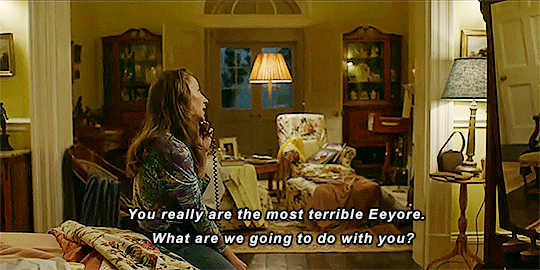

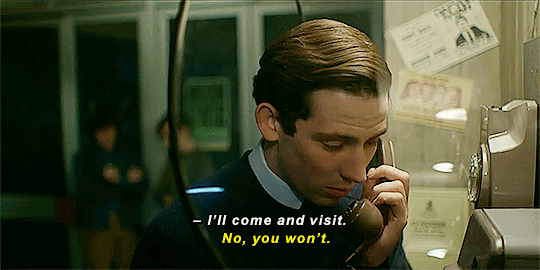


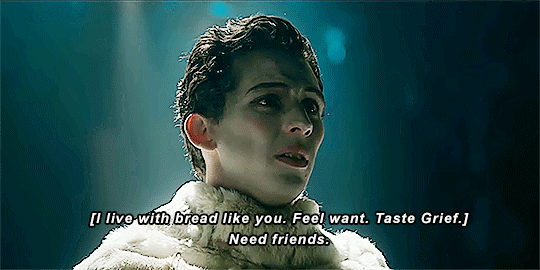
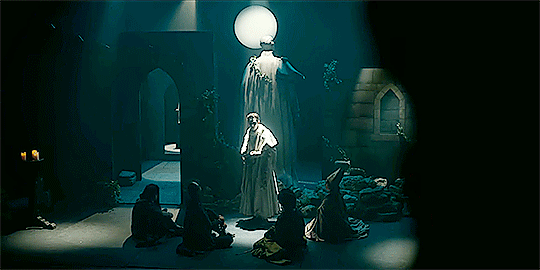

Rewatching Favourite Scenes:-
The Crown 3x06: Little Sis Supports the Drama King
In Season 3 of The Crown, 20-year-old Prince Charles was sent to Aberystwyth to learn Welsh in preparation for his investiture as Prince of Wales – real life events which occurred in 1969. The real Charles struggled to feel welcome in the country, grappling with the language as well as anti-royalist sentiment : -
“I remember going round parts of Wales and being met by demonstrations ... you didn’t quite know what was going to happen. In those days, bombs went off.”
It does seem likely that the homesick prince would phone his then 18-year-old sister Anne for (adorably snarky) support during this turbulent time. With less than 2 years between them, the royal siblings have long been said to "rely on one another."
Anne continued to cheer her brother on. Following his time in Wales, Charles returned to Cambridge and, rather surprisingly, decided to pursue acting alongside his academic studies. The teenage princess was spotted watching in the audience as Charles performed a skit as a weather forecaster which he had written himself.
"[Charles] probably would have made it as a comic, if he'd been that way inclined,” said comedy writer John Lloyd, a fellow performer at Trinity College Dryden Society.
Other performances included Shakespeare. Perhaps one day Charles the drama king might become a Netflix star for real, with Princess Anne in best supporting role.
THE CROWN S6 PT I premieres on Netflix: Thurs 16th Nov 2023
*The Crown TV: proudly NOT using AI/ChatGPT to create original content since 2017.
#the crown#prince charles#princess anne#josh o'connor#erin doherty#LOVE their relationship in the show <3#both hugely talented actors#favourite scenes#season 3#3x06#gifs#articles
64 notes
·
View notes